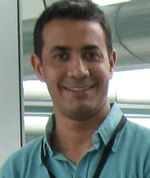Integrated pre-drill and real-time geomechanical modelling brings significant benefits to deepwater wildcat exploration drilling campaign – a case study
M. Sadegh Asadi A D , Amitava Ghosh B , Sanjeev Bordoloi C and Michael Reese CA Baker Hughes, Level 14, 216 St Georges Terrace, Perth, WA 6000, Australia.
B Baker Hughes, 11th Floor, Menara Tan & Tan, Kuala Lumpur, Malaysia.
C Baker Hughes, 2001 Rankin Road, Houston, Texas, USA.
D Corresponding author. Email: Sadegh.Asadi@bakerhughes.com
The APPEA Journal 57(2) 698-703 https://doi.org/10.1071/AJ16245
Accepted: 3 March 2017 Published: 29 May 2017
Abstract
This case study demonstrates the significance of integrated pre-drill geomechanical modelling and real-time monitoring for drilling wildcat exploratory wells in the deepwater settings of an offshore field in South-East Asia. The key challenges in the area include deeper water depths (1.6 km), lack of relevant offset well information and a complex geological setting. In this project, the primary input data for the pre-drill geomechanical model were low resolution 2D seismic velocities derived from an un-calibrated velocity model and petrophysical data from an offset well located in shallow waters, 100 km away from the deepwater prospect.
During pre-drill planning, a contingency casing plan was put in place to consider the uncertainties in the model and cover the worst-case scenario of high pore pressure (PP). To reduce the uncertainty during drilling, the well was monitored in real-time and the pre-drill predictions improved whenever new information or data became available. The objective was to have good data coverage to assist in real-time geomechanical modelling for operational decision making.
Real-time wellbore stability monitoring was carried out by utilising all available drilling and logging data as well as logging while drilling (LWD), pressure measurements and seismic while drilling (SWD) velocities. Wellsite interpretation on cuttings, cavings and formation gases were also integrated into the model predictions. Based on real-time monitoring, pre-drill predictions and model parameters were continuously updated for the next planned section at the end of each section target depth (TD).
Interactive real-time monitoring with continuous pre-drill model updates before drilling the subsequent sections helped to not only deepen the intermediate hole sections, but also to drill efficiently with proper mud weight management and without any significant wellbore instability issues. This integrated workflow helped to successfully drill two exploratory wells, with the major benefit of eliminating the contingency 6ʹʹ slim-hole section.
Keywords: exploration well, pore pressure prediction, real-time monitoring, surface seismic, velocity model, wellbore stability analysis.

M. Sadegh Asadi is a geomechanics specialist at Baker Hughes based in Perth, Australia. Sadegh has more than 10 years experience in mining and oil and gas consulting and service companies in Iran and Australia. He has also worked as a researcher at Curtin University and conducted rock mechanics laboratory experiments and numerical simulations for petroleum research projects. In the last seven years, Sadegh has conducted studies in the Asia-Pacific region and is experienced in mature field geomechanics in depleted reservoirs, extended reach drilling, real-time wellbore stability assessments for deepwater wells and sand production prediction and management. Sadegh holds a PhD in Petroleum Engineering from Curtin University of Australia and is a member of SPE and ISRM societies. |

Amitava Ghosh is a Geologist by profession, and has worked in the petroleum industry for both major and private oil companies along with service sector for ~15 years. He has extensive experience in PP prediction and geomechanical modelling with projects spread across the world. His role in Baker Hughes is that of a Geomechanics Team Leader for South-East Asia. He has previously worked with Reliance Industries and Global Pore Pressure Prediction Team of Shell. He holds a Master’s degree in Geology from Jadavpur University and a Master of Technology from I.I.T Kharagpur, India. |

Sanjeev Bordoloi is a geoscientist by training and holds a Master’s degree in Geology. He has more than 22 years of experience in the petroleum sector, having worked for both NOC and independent oil companies, as well as the service sector. He is a recognised expert in PP modelling. He has extensive experience in drilling and reservoir geomechanics, along with seismic interpretation and sequence stratigraphy, subsurface geological modelling, deepwater and High Pressure High Temperature well planning, operations and wellsite geology. He is presently based in Houston, USA and holds the position of Global Lead, Geomechanics for Baker Hughes Inc. Bordoloi is a member of SPE and EAGE. |

Michael Reese is a multi-disciplinary geologist/engineer with over 38 years of operational experience within oil and gas and service industries. Reese has worked a diverse range of roles including Global Geomechanics Team Lead, Geological Applications Supervisor, Reservoir Navigation Team Lead EHBU, PressTEQ ECD Management Supervisor and LWD Engineer. Before BHI, Reese worked as an Exploration/Development geologist for ECD Midcon Exploration (7 years), Schlumberger (1 year) and Dresser Magcobar Drilling Fluids (1 year). His current role in Baker Hughes is a global advisor for Real-time Geomechanics group based in Houston, where he is responsible for real-time PP management, wellbore stability operations, compliance and training. Reese has obtained several patents and authored numerous professional papers related to geomechanics and wellbore stability. He has a wide range of experience in PP and wellbore stability modelling using petrophysical, drilling and geophysical data, along with extensive wellsite experience. Has a degree in Petroleum Geology (1979) and a Professional Geologist certification (#2556) for the State of Texas. |
References
Asadi, M. S., Khaksar, A., White, A., Yao, Z., and King, P. (2014). Challenges in Defining Fracture Gradient for Highly Deviated Wells in the Presence of Natural Fractures in Deepwater Environments. In ‘Proceedings of the 48th U.S. American Rock Mechanics Association Conference’. ARMA-2014–7010.Bell, W. D. (2002). Velocity Estimation for Pore Pressure Prediction. In Huffman, A. and Bowers, G. (Eds) Pressure Regimes in Sedimentary Basins and their Prediction. In ‘Proceedings of AAPG Memoir’, 76, 177–215.
Ghosh, A., Bordoloi, S., Maulana, H., Hakimi, H. S., and Bakar, A. F. (2014). Pore Pressure Prediction in Deep Water Settings – A Case Study from Offshore Brunei. In ‘Proceedings of International Petroleum Technology Conference (IPTC)’, Kuala Lumpur, Malaysia, 10 December 2014’.
Huffman, R. A. (2002). The Future of Pressure Prediction Using Geophysical Methods. In Huffman, A. and Bowers, G. (Eds) Pressure Regimes in Sedimentary Basins and their Prediction. In ‘Proceedings of AAPG Memoir’, 76, 217–233.
Omar, M. M., Rasli, M. F., Paimin, M. R., Maulana, H., Ghosh, A., and Abidin, M. Z. (2016). Overcoming Challenges in Pore Pressure Prediction and Wellbore Stability in Brunei Ultra Deepwater Exploration Well Campaign. In ‘Proceedings of Asia Pacific Oil & Gas Conference and Exhibition’ October 2016. SPE-182432-MS.
Sayers, C. M., Johnson, G. M., and Denyer, G. (2002). Predrill pore-pressure prediction using seismic data Geophysics 67, 1286–1292.
| Predrill pore-pressure prediction using seismic dataCrossref | GoogleScholarGoogle Scholar |


